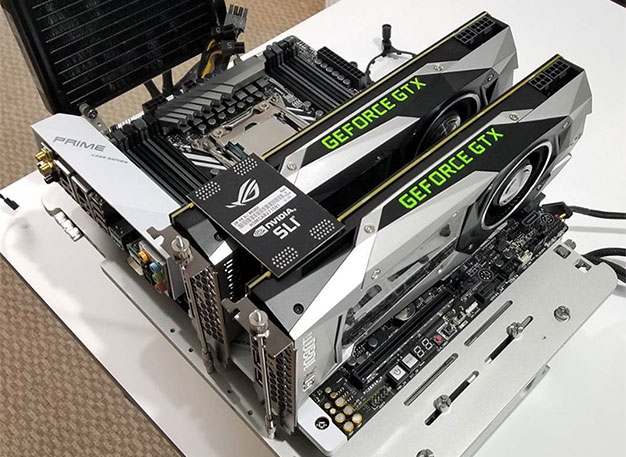Intel Core i9-7900X And Core i7-7740X CPU Review: Skylake-X and Kaby Lake-X Debut
Core i9-7900X And Core i7-7740X - Test Setup, SANDRA, And PCMark
Test System Configuration Notes: When configuring our test systems for this article, we first made sure all firmware was up to date, then we entered their respective system BIOSes / UEFI and set each board to its "Optimized" or "High performance" defaults. We then saved the settings, re-entered the BIOS and set the memory frequency to the maximum officially supported speed for the given platform (without overclocking). The SSDs were then formatted, and the latest build of Windows 10 Pro x64 was installed.

Skylake X Installed On An ASUS Prime X299-Deluxe With A Pair Of GTX 1080 Tis
When the Windows installation was complete, we fully updated the OS, and installed all of the drivers necessary for our components. Auto-Updating and Windows Defender were then disabled, and we installed all of our benchmarking software, performed a disk clean-up, and cleared any temp and prefetch data. Finally, we enabled Windows Quiet Hours and let the systems reach an idle state before invoking a test. Also note, that to ensure AMD's SenseMI technology was performing to its full potential, the Ryzen-powered systems used Windows' High Performance power profile.
|
|
System 1: |
System 2: |
System 3: |
System 4: |
|
We began our testing with the latest version of SiSoftware's SANDRA 2016 SP3, the System ANalyzer, Diagnostic and Reporting Assistant. We ran four of the built-in sub-system tests that partially comprise the suite with Intel's latest processors (CPU Arithmetic, Multimedia, Cache and Memory, and Memory Bandwidth). All of the scores reported below were taken with the CPUs running at their default settings, with 32/16GB of DDR4 RAM running in dual-channel mode Core i7-7740X and quad-channel mode of the Core i9-7900X on the ASUS Prime X299 Deluxe motherboard.
Due to its similarities with the Core i7-7700K, the Core i7-7740X puts up similar numbers in all of the SANDRA tests we ran. The powerful Core i9-7900X, however, is a different sort of animal. Its 10 cores and relatively high clocks result in some of the best arithmetic scores we have seen to date. Its re-architected and larger L2 cache results in much better overall performance, and the platform puts up a massive 55+GB/s of memory bandwidth.
|
PCMark 8 v2 is the latest version in Futuremark’s series of popular PC benchmarking tools. It is designed to test the performance of all types of systems, from tablets to desktops. PCMark 8 offers five separate benchmark tests -- in addition to battery life testing -- to help consumers find devices that offers the perfect combination of efficiency and performance for their particular use case.
This latest version of the suite improves the Home, Creative and Work benchmarks with new tests using popular open source applications for image processing, video editing and spreadsheets. A wide variety of workloads have also been added to the Work benchmark to better reflect the way PCs are used in enterprise environments. These tests can be run with or without OpenCL acceleration. We chose to run with OpenCL acceleration enabled to leverage all of the platforms’ available CPU and GPU compute resources…

The Core i9-7900X led the pack in our PCMark 8 tests, besting Intel's previous-generation 10-core processors (the Core i7-6950X) by a few percentage points in both modules.







